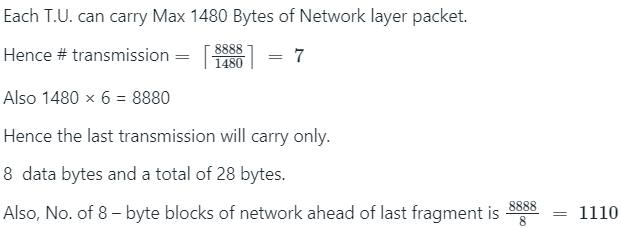Test: Ipv4, IP Packet - Computer Science Engineering (CSE) MCQ
15 Questions MCQ Test GATE Computer Science Engineering(CSE) 2026 Mock Test Series - Test: Ipv4, IP Packet
An IP datagram of size 1000 bytes arrives at a router. The router has to forward this packet on a link whose MTU (maximum transmission unit) is 100 bytes. Assume that the size of the IP header is 20 bytes. The number of fragments that the IP datagram will be divided into for transmission is:
In the TCP/IP protocol suite, which one of the following is NOT part of the IP header?
One of the header fields in an IP datagram is the Time-to-Live (TTL) field. Which of the following statements best explainsthe need for this field?
Host A (on TCP/IP v4 network A) sends an IP datagram D to host B (also on TCP/IP v4 network B). Assume that no error occurred during the transmission of D. When D reaches B, which of the following IP header field(s) may be different from that of the original datagram D?
i. TTL
ii. Checksum
iii. Fragment Offset
An IP router with a Maximum Transmission Unit (MTU) of 1500 bytes has received an IP packet of size 4404 bytes with an IP header of length 20 bytes. The values of the relevant fields in the header of the third IP fragment generated by the router for this packet are:
Host A sends a UDP datagram containing 8880 bytes of user data to host B over an Ethernet LAN. Ethernet frames maycarry data up to 1500 bytes (i.e. MTU = 1500 bytes). Size of UDP header is 8 bytes and size of IP header is 20 bytes. Thereis no option field in IP header. How many total number of IP fragments will be transmitted and what will be the contents ofoffset field in the last fragment?
Which of the following assertions is FALSE about the Internet Protocol (IP)?
Consider three IP networks and Host in network sends messages each containing 180 bytes of application data to a host in network. The TCP layer prefixes a 20-byte header to the message. This passes through an intermediate network. The maximum packet size, including 20 byte IP header, in each network, is:
A: 1000 bytes
B: 100 bytes
C: 1000 bytes
The network A and B are connected through a 1 Mbps link, while B and C are connected by a 512 Kbps link (bps = bits per second).
Assuming that the packets are correctly delivered, how many bytes, including headers, are delivered to the IP layer at the destination for one application message, in the best case? Consider only data packets.
Consider three IP networks A,B and C. Host HA in network A sends messages each containing 180 bytes of application data to a host Hc in network C. The TCP layer prefixes 20 byte header to the message. This passes through an intermediate network B. The maximum packet size, including 20 byte IP header, in each network is:
A: 1000 bytes
B: 100 bytes
C: 1000 bytes
The network A and B are connected through a 1 Mbps link, while B and C are connected by a 512 Kbps link (bps = bits per second).
What is the rate at which application data is transferred to host ? Ignore errors, acknowledgements, and other overheads.
For which one of the following reasons does internet protocol(IP) use the time-to-live(TTL) field in IP datagram header?
In the IPv4 addressing format, the number of networks allowed under Class C addresses is:
In an IPv4 datagram, the M bit is 0, the value of HLEN is 10, the value of total length is 400 and the fragment offset value is300. The position of the datagram, the sequence numbers of the first and the last bytes of the payload, respectively are:
The maximum number of IPv4 router addresses that can be listed in the record route (RR) option field of an IPv4 header is ______.
Which of the following fields of an IP header is NOT modified by a typical IP router?
|
57 docs|215 tests
|
|
57 docs|215 tests
|




















